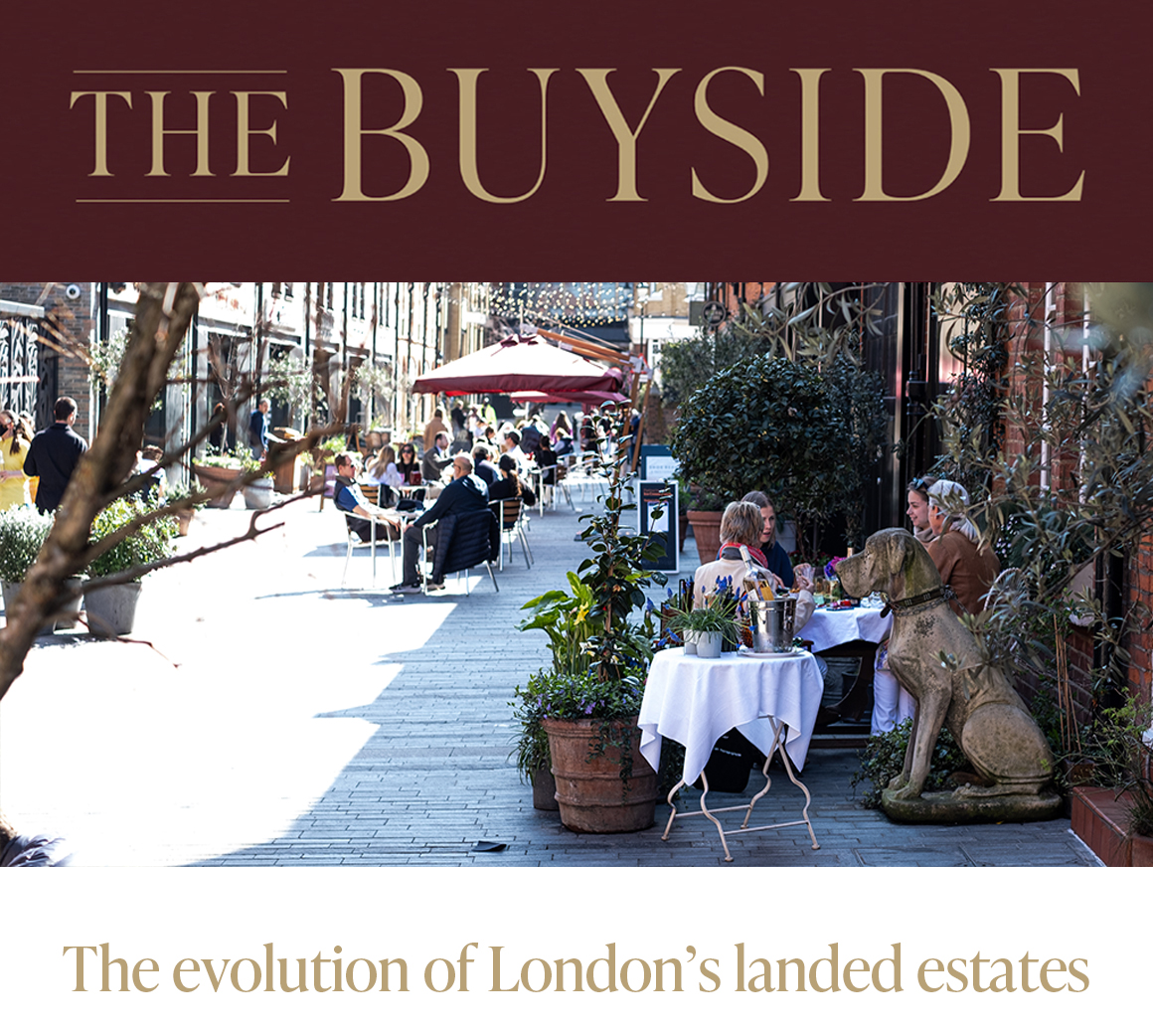
Cadogan’s current redevelopment of Sloane Street – a significant project set to transform the Chelsea thoroughfare – is due to be completed at the end of 2024. The adaptation, approach and ability of London’s landed estates – notably Cadogan, Grosvenor, Howard de Walden, Portman and The Crown – to contribute meaningfully to the infrastructure, vision and development of their local communities make them a vital presence within the fabric of modern London. From Motcombe Street to Mount Street, Marylebone Village to Mayfair, swathes of prime central London have been owned by a handful of families since the late 16th century. We explore the origins, as well as the evolution of these estates which have revitalised pockets of London through some significant schemes, carefully curating and regenerating overlooked areas.
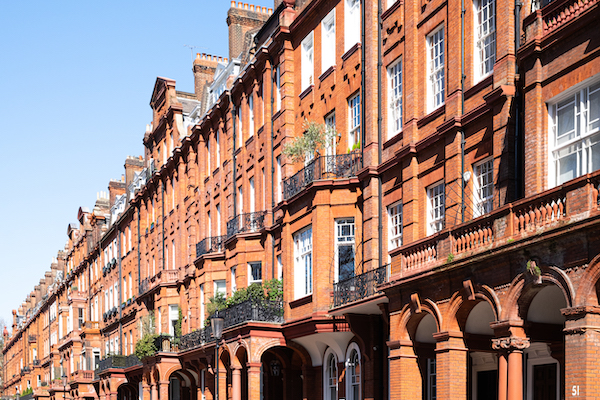
Curating communities: the Cadogan Estate
On a sunny September afternoon, Pavilion Road provides a peaceful enclave. A resident quietly enjoys a coffee on the bistro table outside her house, amongst the ambience of daytime diners. The road has seen a notable transformation in recent years after Cadogan Estate’s consultation with the local community to introduce independent, artisan traders. A hub of eateries now sit alongside a fishmonger, wine merchant, cheesemonger, butcher, bakery and general store contributing to the charming spirit of the street. Running parallel to Pavilion Road is Sloane Street, currently undergoing a major revamp. Cadogan’s enhancement, in partnership with the Royal Borough of Kensington, is set to “create a stunning green boulevard spanning from Knightsbridge to Sloane Square” with wider pavements to improve the sidewalk experience for residents and visitors.
A significant planting scheme – headed by award-winning garden designer Andy Sturgeon – will see over 100 new trees planted alongside flowers and shrubs in a ‘Royal’ colour palette. Cadogan has teamed up with Louis Vuitton and rewilding organisation SUGi to create central London’s first ‘heritage forest’. The 240sqm green oasis will increase the neighbourhood’s biodiversity, as well as beehives and ponds nearby in Cadogan Place Gardens. “These works will strengthen Sloane Street’s position as a global destination for luxury retail and create an even more desirable environment for local residents and businesses – creating a more beautiful, inspiring, greener, cleaner and better-connected environment” says Hugh Seaborn, CEO of Cadogan Estates.
Cadogan’s redevelopment is set to be “the most significant streetscape improvement since it was originally commissioned by the 1st Earl Cadogan in the 18th century”. After being created to link the King’s Road to Knightsbridge for the first Earl Cadogan, Sloane Street became home to many of the ‘Court’ dressmakers, corsetieres and milliners after the 18th century. The physician Sir Hans Sloane originally purchased The Manor of Chelsea – once owned by Henry VIII – from William Cheyne in 1712. The sprawling space encompassed 166 acres and 11 substantial houses to showcase his vast botanical and zoological collections. In 1717 the youngest of his two daughters Elizabeth Sloane married Charles, 2nd Baron Cadogan, resulting in the stewardship of Chelsea passing onto the Cadogan family to form The Cadogan Estate in Chelsea. Sloane Square, Sloane Street and Hans Town retained the namesake of their original owner.
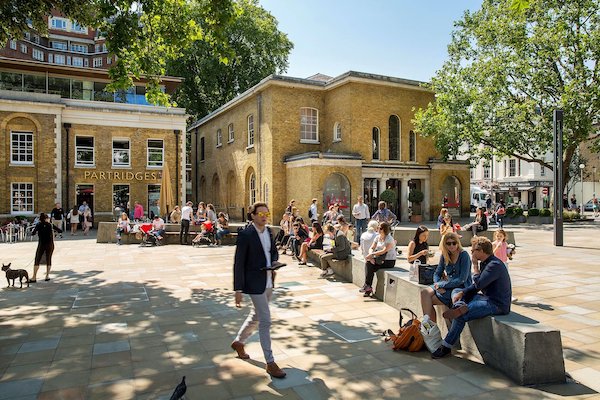
Nearby, Duke of York Square, originally designed in 1801 as a school for military orphans, was acquired by Cadogan in 1998 and redeveloped in 2015 to include 33 stores, 7 restaurants and cafes and a popular food market each Saturday. Notable arts institutions inject a vibrant energy to the area – from the Saatchi Gallery to Cadogan Hall, formerly a run-down church before it was acquired by Cadogan in 2000 and converted into a classical music concert hall creating a subsidised home for the Royal Philharmonic Orchestra.
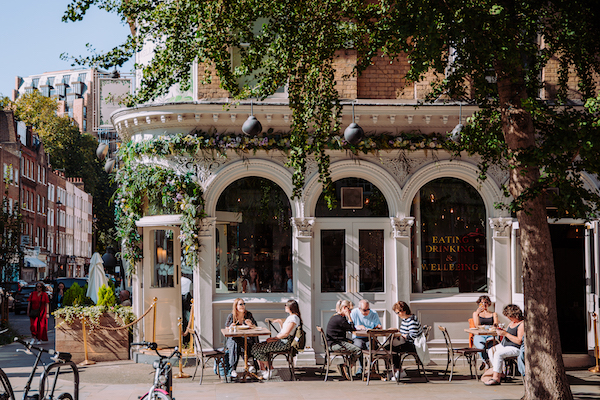
Pioneers: the Howard de Walden Estate
A daily queue snakes round the block outside Parisian steakhouse Le Relais de Venise L’Entrecôte on the recently revitalised Marylebone Lane. Nearby, the stylish St John restaurant which opened last year joins Ottonlenghi’s deli and The Golden Hind fish and chips restaurant which has held fort since 1914. A substantial scheme to revitalise Marylebone Lane, which connects Oxford Street to Marylebone High Street, was completed in 2018. The historic lane, which was shaped to evoke the river course of the Tyburn River buried underneath, once a tributary of the River Thames, has been sensitively redeveloped to create a charming setting between its lively Oxford Street and Marylebone High Street neighbours. The re-designed lane now features wider footways, new paving, trees and street furniture enhancing the environment for local residents and businesses.
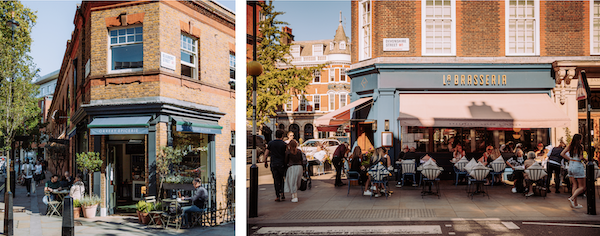
In the early 18th century, tall Georgian houses emerged along the wide roads of Harley Street, Portland Place and Wimpole Street – part of the former Portland Estate, once a quiet country village. Numerous architects contributed to the architectural palette of the burgeoning district, namely the Adams brothers who designed Mansfield Street and the layout of Portland Place, which architect John Nash later lauded as “the most magnificent street in London”. After five generations, The Portland Estate became The Howard de Walden Estate when Lucy Joan Bentick, widow of the 6th Baron Howard de Walden, inherited the land.
Once a neglected part of north London, the estate set about revitalising Marylebone High Street in the 1990s. The emergence of The Conran Shop in 1997 saw an abandoned stable at the north end recreated into the design shop’s second London showroom. Injecting a much-needed cultural presence, the once overlooked area was steadily revitalised into the bustling metropolis of boutiques and eateries we know today. La Fromagerie, Fischer’s, Aubaine and the recently opened Carlotta join a weekly farmers market evoking a village-hub feel.
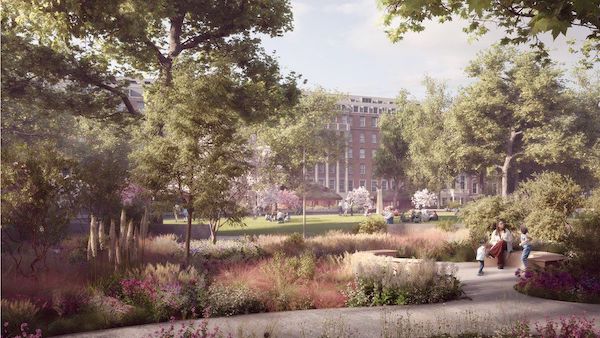
Belgravia & Mayfair: the growth of the Grosvenor Estate
Ahead of Grosvenor Estate’s 300th anniversary in 2026, a transformation of Grosvenor Square is set to begin early next year which will introduce significant new elements such as a shaded garden featuring biodiverse planting, whilst preserving the 6-acre garden’s historic features. “This incredible project will deliver much of what is needed so badly – creating an exceptional environment for everyone who lives in, or comes to, the area” says James Raynor, CEO, Grosvenor Property UK.
Meanwhile, Elizabeth Street, which runs between prestigious Eaton Square and Buckingham Palace Road, is another regenerated area where independent shops are nestled within the Victorian architectural landscape providing an urban haven for residents. As the RFR team passes through between viewings, residents read newspapers outside bakery Poilâne, catch up at the Thomas Cubitt, dip in and out of artisan food spots The Chestnut Bakery, Oliveto or Baker & Spice. Constructed in the mid-19th century, the street underwent significant reconstructive works in 2010 by Grosvenor and Westminster City Council to improve access for pedestrians with the resulting reconfigured thoroughfare creating a more intimate, hushed setting.
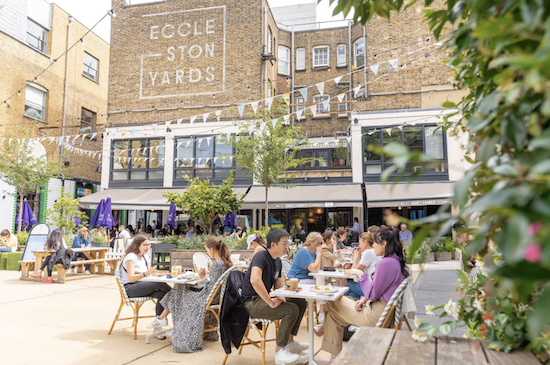
Nearby, a formerly derelict car park was repurposed by Grosvenor in 2018 to create Eccleston Yards that now features popular spots Wild by Tart, Barry’s Bootcamp, Hotpod Yoga and Re:Mind Studio amongst others. Buckley Gray architecture studio created a central courtyard whilst threading a pedestrian connection between two prominent streets. Five neighbouring industrial buildings spanning 80,000 square feet were sensitively refurbished into co-working and creative hubs for food and fashion, with pop-up screenings, food festivals and sporting events hosted alongside.
The Grosvenor family’s association with London property originated in 1677 when the Manor of Ebury – spanning 500 acres of land north of the River Thames which includes much of Mayfair and Belgravia today – was inherited by the Grosvenor family, following the marriage of Sir Thomas Grosvenor and Mary Davies, heiress of the Manor of Ebury. Grosvenor’s development of the district began in the 1720s when pastures, swamps and orchards were replaced with wide, straight streets that largely still exist today with Grosvenor Square at its central focal point. The development of Belgravia by Thomas Cundy and Thomas Cubitt in the early 19th century saw an emergence of Regency style houses, garden squares, crescents and streets. Together with the Estate’s Mayfair property, it encompasses more than 1,500 listed buildings (50 of which are Grade I), whilst Cubitt’s architectural palette of stucco, brick, slate and painted timber sashes remain today.
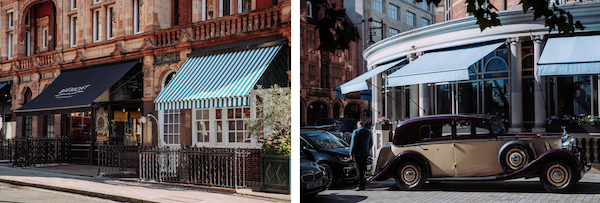
The ever-evolving Estates
Carefully considered, curated pockets within the arteries of the city characterise many of these regenerative areas, creating mini villages within the estates for Londoners to enjoy. Responsible, homogenous estate landlords own, manage and lease the properties through a well-organised infrastructure within sought-after prime residential, retail and commercial areas, in turn increasing the appeal of buying property nearby.
An increased environmental awareness also frames many of the schemes, such as Cadogan’s ambition to become net-zero carbon by 2030 and Grosvenor’s target to have achieved a significant biodiversity net gain by 2030 and be water neutral by 2050. Meanwhile, their collective efforts to champion and weave in smaller independent businesses alongside more established brands epitomises a holistic vision to inject character, charisma and culture to these areas, whilst also building thriving communities.
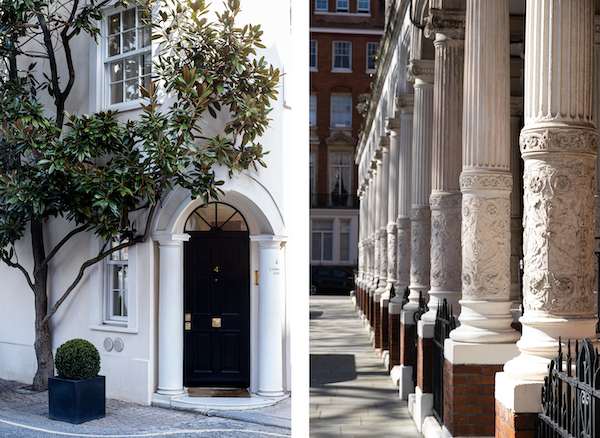
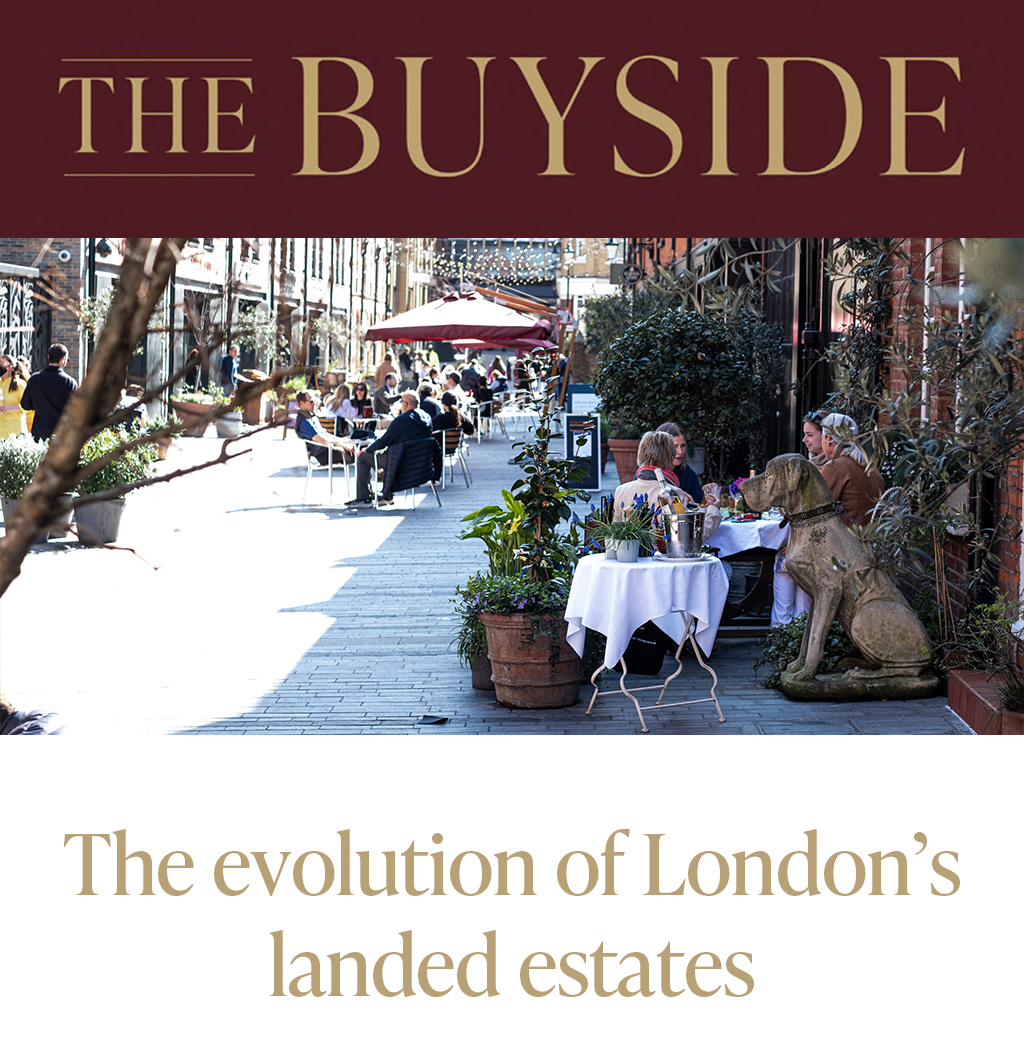
Cadogan’s current redevelopment of Sloane Street – a significant project set to transform the Chelsea thoroughfare – is due to be completed at the end of 2024. The adaptation, approach and ability of London’s landed estates – notably Cadogan, Grosvenor, Howard de Walden, Portman and The Crown – to contribute meaningfully to the infrastructure, vision and development of their local communities make them a vital presence within the fabric of modern London. From Motcombe Street to Mount Street, Marylebone Village to Mayfair, swathes of prime central London have been owned by a handful of families since the late 16th century. We explore the origins, as well as the evolution of these estates which have revitalised pockets of London through some significant schemes, carefully curating and regenerating overlooked areas.

Curating communities: the Cadogan Estate
On a sunny September afternoon, Pavilion Road provides a peaceful enclave. A resident quietly enjoys a coffee on the bistro table outside her house, amongst the ambience of daytime diners. The road has seen a notable transformation in recent years after Cadogan Estate’s consultation with the local community to introduce independent, artisan traders. A hub of eateries now sit alongside a fishmonger, wine merchant, cheesemonger, butcher, bakery and general store contributing to the charming spirit of the street. Running parallel to Pavilion Road is Sloane Street, currently undergoing a major revamp. Cadogan’s enhancement, in partnership with the Royal Borough of Kensington, is set to “create a stunning green boulevard spanning from Knightsbridge to Sloane Square” with wider pavements to improve the sidewalk experience for residents and visitors.
A significant planting scheme – headed by award-winning garden designer Andy Sturgeon – will see over 100 new trees planted alongside flowers and shrubs in a ‘Royal’ colour palette. Cadogan has teamed up with Louis Vuitton and rewilding organisation SUGi to create central London’s first ‘heritage forest’. The 240sqm green oasis will increase the neighbourhood’s biodiversity, as well as beehives and ponds nearby in Cadogan Place Gardens. “These works will strengthen Sloane Street’s position as a global destination for luxury retail and create an even more desirable environment for local residents and businesses – creating a more beautiful, inspiring, greener, cleaner and better-connected environment” says Hugh Seaborn, CEO of Cadogan Estates.
Cadogan’s redevelopment is set to be “the most significant streetscape improvement since it was originally commissioned by the 1st Earl Cadogan in the 18th century”. After being created to link the King’s Road to Knightsbridge for the first Earl Cadogan, Sloane Street became home to many of the ‘Court’ dressmakers, corsetieres and milliners after the 18th century. The physician Sir Hans Sloane originally purchased The Manor of Chelsea – once owned by Henry VIII – from William Cheyne in 1712. The sprawling space encompassed 166 acres and 11 substantial houses to showcase his vast botanical and zoological collections. In 1717 the youngest of his two daughters Elizabeth Sloane married Charles, 2nd Baron Cadogan, resulting in the stewardship of Chelsea passing onto the Cadogan family to form The Cadogan Estate in Chelsea. Sloane Square, Sloane Street and Hans Town retained the namesake of their original owner.

Nearby, Duke of York Square, originally designed in 1801 as a school for military orphans, was acquired by Cadogan in 1998 and redeveloped in 2015 to include 33 stores, 7 restaurants and cafes and a popular food market each Saturday. Notable arts institutions inject a vibrant energy to the area – from the Saatchi Gallery to Cadogan Hall, formerly a run-down church before it was acquired by Cadogan in 2000 and converted into a classical music concert hall creating a subsidised home for the Royal Philharmonic Orchestra.

Pioneers: the Howard de Walden Estate
A daily queue snakes round the block outside Parisian steakhouse Le Relais de Venise L’Entrecôte on the recently revitalised Marylebone Lane. Nearby, the stylish St John restaurant which opened last year joins Ottonlenghi’s deli and The Golden Hind fish and chips restaurant which has held fort since 1914. A substantial scheme to revitalise Marylebone Lane, which connects Oxford Street to Marylebone High Street, was completed in 2018. The historic lane, which was shaped to evoke the river course of the Tyburn River buried underneath, once a tributary of the River Thames, has been sensitively redeveloped to create a charming setting between its lively Oxford Street and Marylebone High Street neighbours. The re-designed lane now features wider footways, new paving, trees and street furniture enhancing the environment for local residents and businesses.

In the early 18th century, tall Georgian houses emerged along the wide roads of Harley Street, Portland Place and Wimpole Street – part of the former Portland Estate, once a quiet country village. Numerous architects contributed to the architectural palette of the burgeoning district, namely the Adams brothers who designed Mansfield Street and the layout of Portland Place, which architect John Nash later lauded as “the most magnificent street in London”. After five generations, The Portland Estate became The Howard de Walden Estate when Lucy Joan Bentick, widow of the 6th Baron Howard de Walden, inherited the land.
Once a neglected part of north London, the estate set about revitalising Marylebone High Street in the 1990s. The emergence of The Conran Shop in 1997 saw an abandoned stable at the north end recreated into the design shop’s second London showroom. Injecting a much-needed cultural presence, the once overlooked area was steadily revitalised into the bustling metropolis of boutiques and eateries we know today. La Fromagerie, Fischer’s, Aubaine and the recently opened Carlotta join a weekly farmers market evoking a village-hub feel.

Belgravia and Mayfair: the growth of the Grosvenor Estate
Ahead of Grosvenor Estate’s 300th anniversary in 2026, a transformation of Grosvenor Square is set to begin early next year which will introduce significant new elements such as a shaded garden featuring biodiverse planting, whilst preserving the 6-acre garden’s historic features. “This incredible project will deliver much of what is needed so badly – creating an exceptional environment for everyone who lives in, or comes to, the area” says James Raynor, CEO, Grosvenor Property UK.
Meanwhile, Elizabeth Street, which runs between prestigious Eaton Square and Buckingham Palace Road, is another regenerated area where independent shops are nestled within the Victorian architectural landscape providing an urban haven for residents. As the RFR team passes through between viewings, residents read newspapers outside bakery Poilâne, catch up at the Thomas Cubitt, dip in and out of artisan food spots The Chestnut Bakery, Oliveto or Baker & Spice. Constructed in the mid-19th century, the street underwent significant reconstructive works in 2010 by Grosvenor and Westminster City Council to improve access for pedestrians with the resulting reconfigured thoroughfare creating a more intimate, hushed setting.

Nearby, a formerly derelict car park was repurposed by Grosvenor in 2018 to create Eccleston Yards that now features popular spots Wild by Tart, Barry’s Bootcamp, Hotpod Yoga and Re:Mind Studio amongst others. Buckley Gray architecture studio created a central courtyard whilst threading a pedestrian connection between two prominent streets. Five neighbouring industrial buildings spanning 80,000 square feet were sensitively refurbished into co-working and creative hubs for food and fashion, with pop-up screenings, food festivals and sporting events hosted alongside.
The Grosvenor family’s association with London property originated in 1677 when the Manor of Ebury – spanning 500 acres of land north of the River Thames which includes much of Mayfair and Belgravia today – was inherited by the Grosvenor family, following the marriage of Sir Thomas Grosvenor and Mary Davies, heiress of the Manor of Ebury. Grosvenor’s development of the district began in the 1720s when pastures, swamps and orchards were replaced with wide, straight streets that largely still exist today with Grosvenor Square at its central focal point. The development of Belgravia by Thomas Cundy and Thomas Cubitt in the early 19th century saw an emergence of Regency style houses, garden squares, crescents and streets. Together with the Estate’s Mayfair property, it encompasses more than 1,500 listed buildings (50 of which are Grade I), whilst Cubitt’s architectural palette of stucco, brick, slate and painted timber sashes remain today.

The ever-evolving Estates
Carefully considered, curated pockets within the arteries of the city characterise many of these regenerative areas, creating mini villages within the estates for Londoners to enjoy. Responsible, homogenous estate landlords own, manage and lease the properties through a well-organised infrastructure within sought-after prime residential, retail and commercial areas, in turn increasing the appeal of buying property nearby.
An increased environmental awareness also frames many of the schemes, such as Cadogan’s ambition to become net-zero carbon by 2030 and Grosvenor’s target to have achieved a significant biodiversity net gain by 2030 and be water neutral by 2050. Meanwhile, their collective efforts to champion and weave in smaller independent businesses alongside more established brands epitomises a holistic vision to inject character, charisma and culture to these areas, whilst also building thriving communities.


